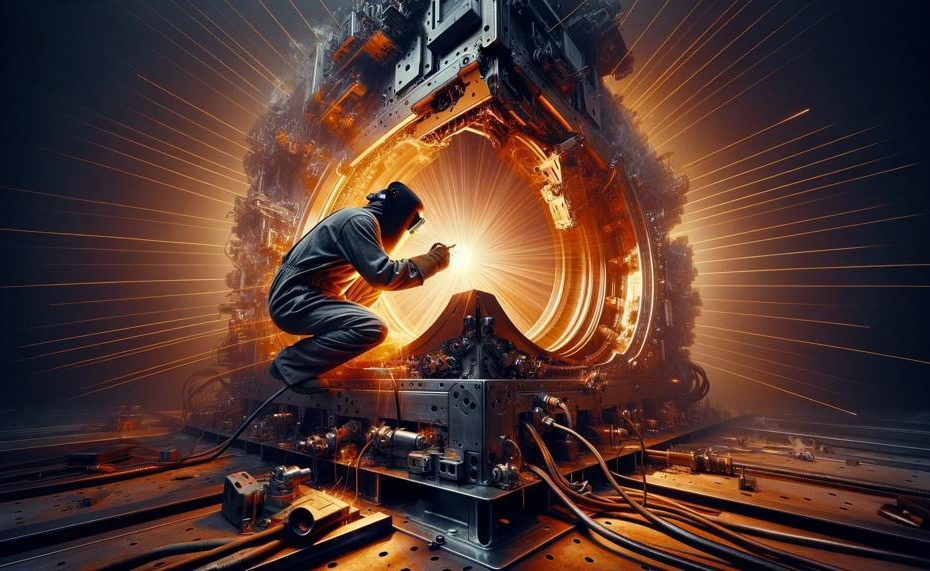We’ll delve into the hidden side of welding in this investigation, illuminating the many radiations it emits and their effects.
We are going to explore the hidden facets of this amazing process, from the workshop floor to the safety measures that keep us safe.
So, does welding produce radiation?
Yes, welding produces radiation, including ultraviolet (UV), infrared, and visible radiation. Arc welding and laser welding emit UV radiation, which can cause eye melanoma, cataracts, and burns to exposed skin. The risk of developing cancer from welding depends on the type of welding process used and the material being welded.
UV radiation in a welding arc can burn unprotected skin, just like UV radiation in sunlight. This hazard is true for direct exposure to UV radiation as well as radiation that is reflected from metal surfaces, walls, and ceilings.
Long-term exposure to UV radiation can cause cataracts in the eyes, causing blurred vision, and in worst cases, ocular melanoma (OM) can form. OM causes vision loss and can be fatal as the malignant tumor spreads throughout the body to the liver, lungs, and bones.
Welding and cutting operations emit non-ionizing radiation, meaning they do not produce X-rays, or any other ionizing radiation.
Employers should provide protective clothing, such as fire retardant clothing, welder’s jackets and pants, to protect against UV radiation. Neck protection and welding gloves are also recommended to protect areas of the skin not protected by other clothing.
Join us as we navigate through the sparks and shadows of welding, where science meets craft, and discover what lies beneath the surface of this age-old technique. Whether you’re a seasoned professional or simply curious about the art and science of welding, this article promises insights and knowledge to spark your interest.
Contents
Does welding produces radiation?
Welding, a craft blending skill with the harsh tang of metal, indeed emits radiation, kindling both wonder and caution.
This process, essential in sculpting the skeleton of our modern world, unfurls a spectrum of radiations, invisible threads that dance with danger and necessity.
Radiation Types from Welding:
Welding’s intense flames whisper secrets of ultraviolet (UV) rays, infrared (IR) radiation, and, to a lesser extent, visible light.
These emissions, while crucial to the alchemy of joining metals, bear risks to the unwary.
| Radiation Type | Characteristic | Potential Harm |
| Ultraviolet (UV) Radiation | High-energy, ionizing | Skin burns, eye damage (arc eye), increased risk of skin cancer |
| Infrared (IR) Radiation | Heat-producing, non-ionizing | Thermal burns, heat stress |
| Visible Light Radiation | Non-ionizing | Temporary vision impairment, glare discomfort |
Types of radiations produced by welding
Welding, a process integral to industries far and wide, from skyscrapers to automobiles, not only melds metals but also emits a spectrum of radiations, each with its unique influence on health.
Understanding these emissions is paramount for safeguarding those who toil within the glow of the welder’s flame.
Types of Radiation and Their Health Impacts
| Radiation Type | Description | Health Impact |
| Ultraviolet (UV) Radiation | High-energy, invisible light produced by welding arcs. | Can lead to skin burns, skin cancer, and eye damage, including “welder’s flash.” |
| Infrared (IR) Radiation | Heat radiation also emitted by the welding process. | May cause thermal burns and contribute to eye conditions such as cataracts. |
| Visible Light Radiation | Bright light generated by the welding arc. | Intense glare can cause eye strain and temporary flash blindness. |
| Electromagnetic Fields (EMF) | Electric and magnetic fields generated by welding current. | Long-term exposure linked to various health concerns, including potential increases in certain types of cancer. |
Safeguarding Against Harm
Wearing the armour of safety, welders can shield themselves from these unseen assailants. Helmets with darkened faceplates fend off the piercing gaze of UV and IR radiation, while high-quality gloves and aprons ward off the searing touch of sparks and heat. Moreover, ventilated workspaces whisk away toxic fumes, reducing the risk of respiratory afflictions.
But the battle doesn’t end with personal gear. Knowledge and vigilance stand as the welder’s steadfast allies.
By understanding the nature of these radiations and incorporating safety practices into their daily forge, welders and employers alike can greatly diminish the peril these invisible emissions pose.
How can Welding radiation affects the skin?
Exposure to welding radiation can pose significant risks to the skin, encompassing a spectrum of health effects, from acute to chronic conditions. The primary culprit behind these risks is ultraviolet (UV) radiation, known for its ability to damage skin cells and heighten the risk of skin cancer.
However, visible light and infrared (IR) radiation, alongside high-frequency electromagnetic fields (EMFs), also contribute to the potential damage. Here’s a breakdown of how each type of radiation impacts the skin and the importance of protective measures for welders.
Impact of Different Types of Welding Radiation on the Skin:
| Type of Radiation | Potential Skin Effects | Preventative Measures |
| UV Radiation | Increases risk of skin cancer (squamous cell carcinoma and basal cell carcinoma), skin burns, and premature aging. | Use of protective clothing, appropriate welding helmets, and UV-blocking creams. |
| Visible Light | Can cause heat burns and pigmentation changes on the skin. | Wearing UV-protective glasses and ensuring workspace is well-shielded. |
| IR Radiation | Leads to deep thermal damage, including burns and tissue death. | Implementing IR-reflective barriers and using protective gear that covers exposed skin. |
| High-frequency EMFs | May induce electrical currents in the skin, causing nerve-related effects like tingling or numbness. | Maintaining a safe distance from the welding source and limiting exposure time. |
Understanding the Risks and Protecting the Skin:
It’s crystal clear that the welding process emits radiation that can have grave consequences for the skin, ranging from burns and irritation to an increased risk of cancer. The severity of these health effects largely depends on the type of welding, the materials being welded, exposure duration, and the welder’s proximity to the source.
Welders must arm themselves with knowledge and the right gear to fend off these risks. Protective clothing, proper shielding, and reducing time spent welding are key. Employers also play a crucial role in safeguarding their workers by ensuring a safe working environment and providing comprehensive training on the dangers of welding radiation.
Despite the hazards, understanding the risks and taking appropriate precautions can significantly mitigate the potential harm welding radiation poses to the skin.
How to protect from welding radiation?
Protecting oneself from the potential radiation produced during welding involves a multifaceted approach. Here’s how to stay safeguarded:
| Protective Measure | Type | Purpose |
| Masks and Respirators | Personal Protective Gear | Prevents inhalation of toxic fumes |
| Goggles and Helmets | Personal Protective Gear | Shields eyes and face from harmful radiation |
| Protective Clothing | Personal Protective Gear | Protects skin against UV radiation |
| Limit Time and Proper Distance | Minimising Exposure | Reduces overall radiation exposure |
| Physical Barriers/Shields | Use of Barriers | Blocks or reduces radiation spread |
| Training | Education | Ensures awareness of risks and safety practices |
| Follow Legal Guidelines | Government Legislation | Ensures compliance with safety standards |
| EMF Protection Products | Additional Measures | Offers extra protection against EMF radiation |
List of PPE to protect from welding radiation

To safeguard oneself from the hazards of welding radiation, it’s critical to don the appropriate Personal Protective Equipment (PPE).
This gear is not just about compliance; it’s about ensuring that welders can carry out their craft safely, minimizing the risks associated with the intense light, heat, and particulates generated during welding operations.
Below is a comprehensive table detailing the essential types of PPE required for this purpose:
| PPE Type | Function | Details |
| Welding Helmet | Protects against UV/IR rays and sparks | Must have auto-darkening feature to adjust to varying light conditions. |
| Safety Glasses | Additional eye protection | Should be worn under helmets to protect against flying debris during prep work. |
| Welding Gloves | Insulates hands from heat | Specifically designed for the type of welding technique being used. |
| Fire-resistant Clothing | Shields skin from UV radiation and burns | Includes items like overalls, shirts, and trousers made from flame-resistant materials. |
| Leather Aprons/Jackets | Extra protection for torso | Provides additional layering against sparks, especially for the front body area. |
| Respirators | Protects from harmful fumes | Selection depends on the specific welding environment; ensures breathable air. |
| Welding Boots | Protects feet from sparks and heavy objects | Should be high-top leather with steel toes, possibly with metatarsal guards. |
| Ear Protection | Shields against loud noise and burns | Options include earplugs or earmuffs, depending on noise level and comfort. |
| Welding Caps/Bandanas | Protects the head and hair | Keeps falling sparks and debris from hair and scalp when welding overhead. |
Embracing this protective gear ensures that welders are shielded from the various hazards posed by welding radiation.
Each piece of PPE plays a crucial role in a comprehensive safety strategy, addressing specific risks associated with welding activities.
It’s not just about slapping on a helmet and gloves; it’s about understanding the function and proper use of each item to ensure maximum protection.
Should you worry about welding radiation?
Absolutely, you should have a healthy respect for the hazards associated with welding radiation. While welding stands as a cornerstone in the realm of industrial craftsmanship, it’s not without its share of dangers, notably radiation exposure.
This isn’t about sparking undue alarm but fostering a vigilant approach to safeguarding health. Here’s a breakdown of the potential health risks and practical measures to mitigate them:
Health Risks of Welding Radiation:
Welding radiation, encompassing ultraviolet (UV), infrared (IR), and visible light, poses significant health risks if proper precautions are not taken.
The immediate concern often gravitates towards the eyes and skin, with potential long-term repercussions demanding equal attention.
| Risk | Effects | Exposure |
| UV Radiation | Skin burns, arc eye/flash burns | Direct and reflected light |
| IR Radiation | Heat cataracts, retinal burns | Excessive heat exposure |
| Visible Light | Eye strain, temporary blindness | Staring at the welding arc |
Conclusion
An essential skill in the industrial fabric, welding releases a range of radiation that poses serious risks to worker health and safety. The invisible yet powerful dance of electromagnetic fields, ultraviolet (UV), infrared (IR), and visible light beams creates a secret ballet of dangers. A careful approach to protection and teaching is necessary because of this intricate interaction.
The armory of personal protection equipment (PPE) watches over metalworkers as they traverse this bright but dangerous realm. Protective gear, goggles, and helmets act as a barrier against the invading dance of radiative forces. But armor is insufficient on its own. The combination of knowledge, which acts as an invisible barrier, and following safety procedures turns the workplace into a safe haven for both creativity and safety.
In order to make sure that the genius of welding points the road toward development rather than harm, employers and welders alike must approach this bright furnace with respect and prudence. They must accomplish this by implementing measures ranging from advanced equipment to knowledgeable practices.





